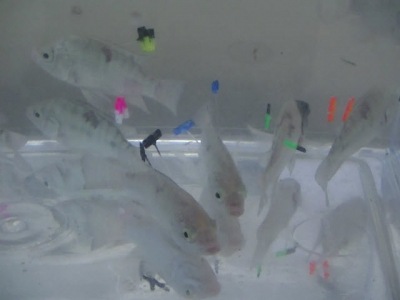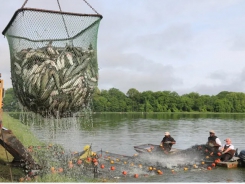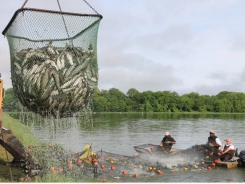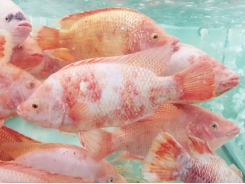The pros and cons of tagging farmed fish

The use of tags to monitor the behaviour of farmed fish can provide scientists with important information, but also create welfare issues, according to a new study.
Tagging fish, such as these tilapia, in tanks appears to have little impact on their behaviour and survival rates, but this isn't the case in sea cages. Photo: Hugues de Verdal, IFREMER
In the study a group of research scientists from the University of Melbourne, the Institute of Marine Research Norway (IMR) and the Norwegian University of Science and Technology used tags to investigate the response of farmed salmon to parasites, track how salmon swim in new cage environments and test their ability to learn new behaviours.
Through this work, the researchers noticed tags do not always work as intended, and sometimes affected the fish negatively.
"If tags are to provide useful information relevant to the whole population of untagged fish, the behaviour and welfare of tagged fish must not be compromised by the tagging process. But if tags change the behaviour or welfare of fish, the information they give may not represent the wider untagged population," the reseachers note.
As a result, they decided to dig deeper and, after receiving funding from the Research Council of Norway, they systematically reviewed studies that used tags to monitor farmed fish behaviour. Several concerning discoveries emerged.
Firstly, tagged fish mortality was 10 times higher in studies conducted in sea cages compared to tanks. In the cages, one in four tagged fish died within the period they were studied, and in general, the longer the study, the higher the mortality rate. And in many studies, important information, like the mortality rates of tagged and untagged fish, was not reported, which makes it difficult to work out the effects of tags.
Why tags affect fish welfare in sea cages
Experiments conducted in small tanks are typically done under controlled culture conditions, where researchers can largely prevent poor water quality and other adverse events, like algal blooms or pollution. In comparison, experiments conducted in large sea cages, filled with thousands of individuals expose fish to stressful condidtions - including fluctuating temperatures, salinity, dissolved oxygen, current, pollutants and pathogens - which can affect their behaviour, welfare and survival.
These findings have several implications:
Results obtained in tanks are likely not transferrable to sea cage environments.
High mortality rates in sea cage experiments call into question how representative tagged fish are of the whole fish population.
Tagging in marine sites poses significant animal welfare issues.
"Tagging is stressful for fish – being captured, handled and undergoing surgery are not experiences a fish would normally go through. In sea cages, fish are also exposed to other stressful conditions like crowding or environmental extremes – and unlike the wild, caged fish cannot swim away from unpleasant conditions," say the researchers.
"We think the additional stressors present in the sea-cage environment make it harder for fish to recover from the initial stress of tagging and that this leads to a lower chance of survival," they add.

Tag types and applicators, from simple t-bar tags (multi-coloured tags with applicator guns) to various electronic tags that are surgically inserted into the body cavities of fish. Photo: Frode Oppedal
"Based on our results, we recommend more rigorous use of the ‘3Rs’ framework when tagging fish in aquaculture, which are the guiding principles for humane use of animals in scientific studies and include:
- Replacement, which encourages removing the use of animals completely.
- When animals must be used, Reduction minimises the number of animals being used.
- Refinement ensures research methods are advanced so that animals experience the least amount of suffering possible."
A paper on the study, published in the journal Reviews in Aquaculture, suggests replacement of tags where possible with unobtrusive, behavioural monitoring technologies - like sonar, video or computer imaging.
However, where researchers need to use tags they recommend reducing the number of fish tagged to a minimum that will still provide large enough sample sizes to get relevant results.
They also have recommendations for future tagging research to refine the tagging procedure by encouraging researchers to:
- Carefully record the tag attachment procedure, including important information like tag dimensions, water temperature and type of anaesthetic used.
- Provide information about any physical effects from tagging, such as if fish display inflammation near the tag attachment site.
- Compare the behaviour of tagged and untagged fish throughout the experiment.
- Report how many tagged fish and how many untagged fish died throughout the experiment.
By reporting this information, it should allow researchers to determine whether tags are negatively affecting the welfare and survival of their experimental fish – and whether or not it’s a good idea to use data from tagged fish to make assumptions about untagged fish.
"Our results shed light on a practice that is gaining popularity – but needs considerable improvement to ensure it is a safe method for fish, which also produces reliable results.
"As tagging technology become cheaper and more sophisticated, tags will continue to be a popular choice among scientists who research farmed fish. While tagging has a lot of promise, it needs significant improvement to safeguard the welfare of tagged fish in aquaculture.
Có thể bạn quan tâm
Phần mềm

Phối trộn thức ăn chăn nuôi

Pha dung dịch thủy canh

Định mức cho tôm ăn

Phối trộn phân bón NPK

Xác định tỷ lệ tôm sống

Chuyển đổi đơn vị phân bón

Xác định công suất sục khí

Chuyển đổi đơn vị tôm

Tính diện tích nhà kính

Tính thể tích ao hồ




 Realising the unmet potential of farming tilapia in…
Realising the unmet potential of farming tilapia in…  Specialist lighting increases tilapia growth rates by 10…
Specialist lighting increases tilapia growth rates by 10…